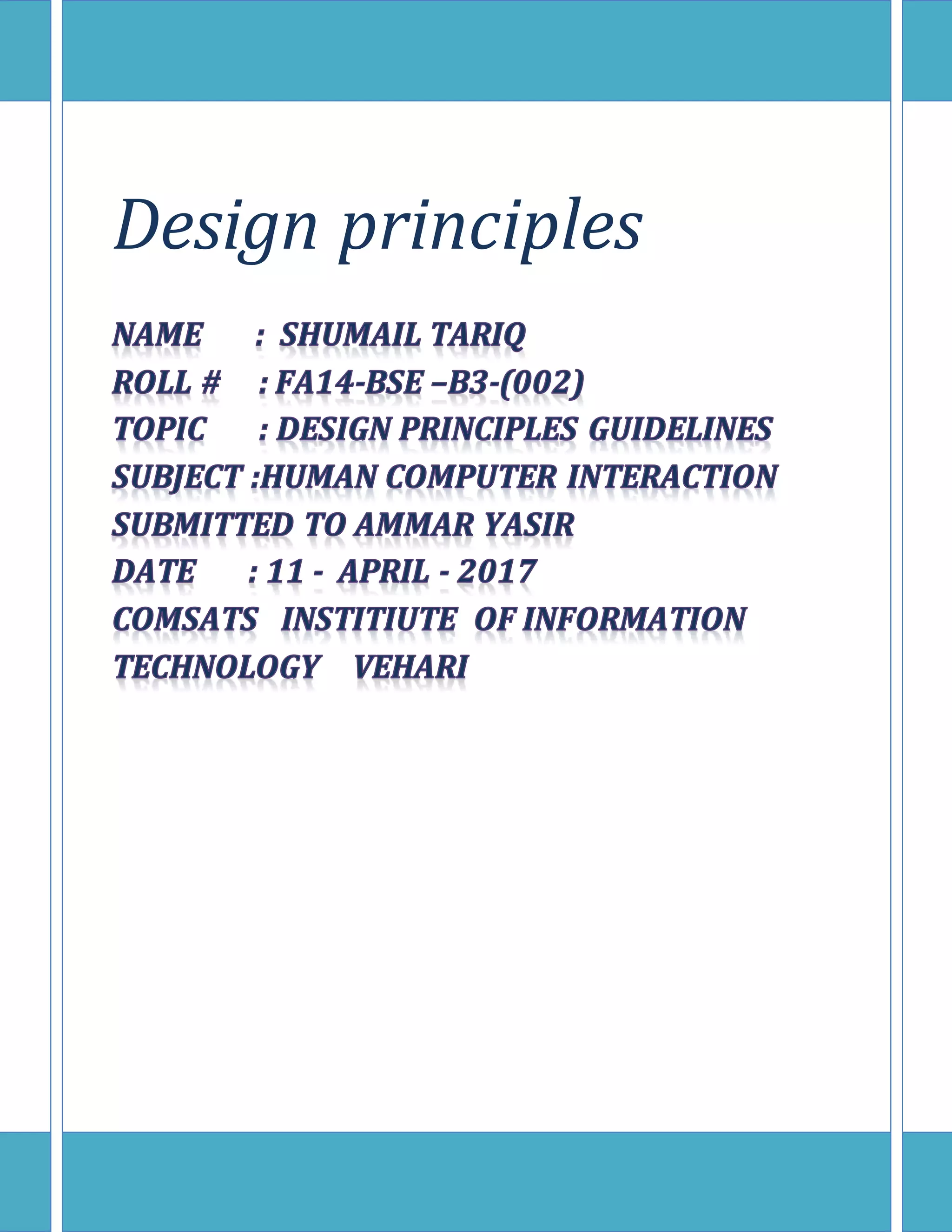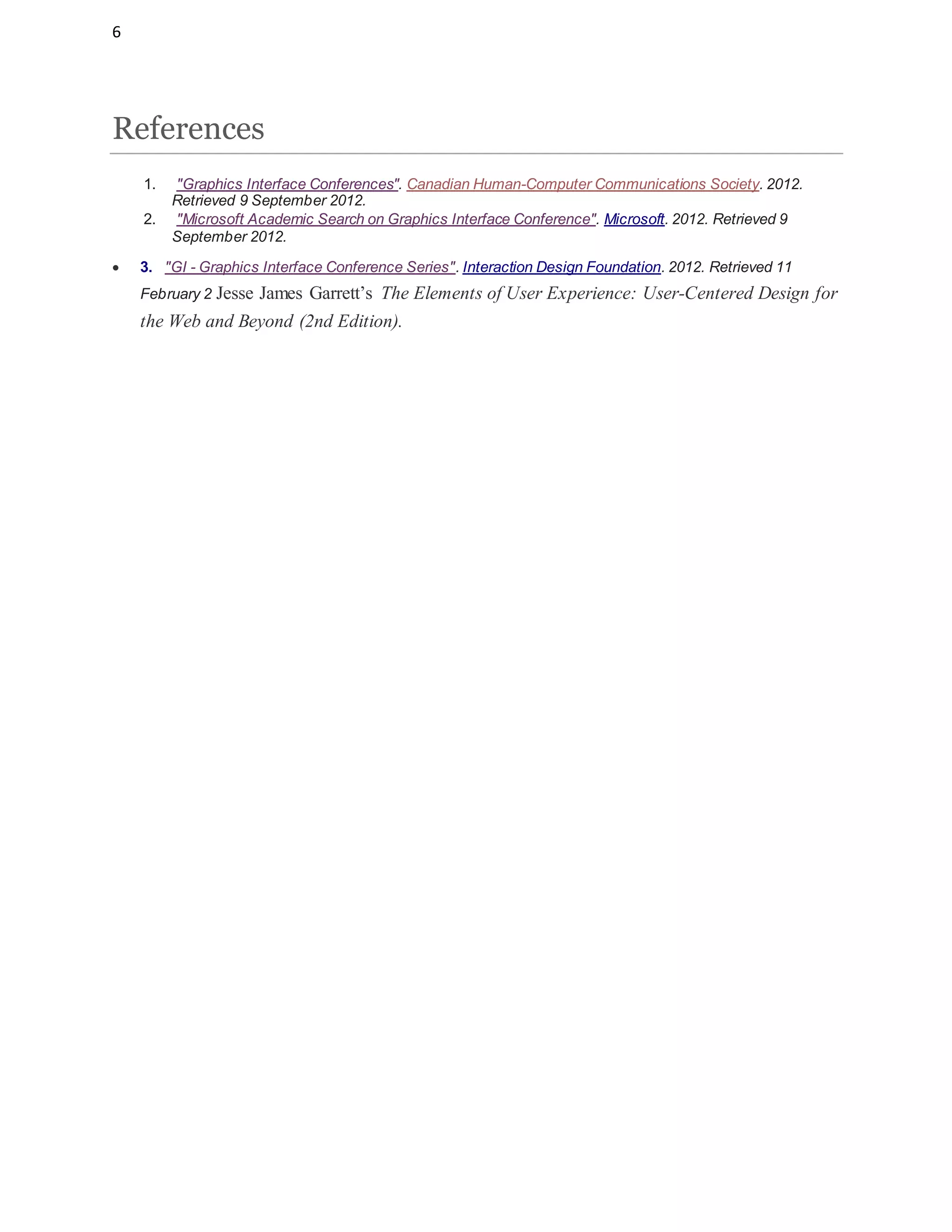The document discusses various design principles for improving usability. It covers principles of learnability, flexibility, and robustness. It also discusses guidelines for interaction design, information display, and data entry. Additionally, it outlines eight "golden principles" of consistency, universal usability, informative feedback, dialog closure, error prevention, reversal of actions, internal locus of control, and reducing memory load. Finally, it lists ten heuristic principles for visibility, matching real world concepts, user control, consistency, error prevention, recognition over recall, efficiency, minimalism, error handling and documentation.

![1
Contents
1] Principles and Guidelines………………page2
1.1] Introduction (usability principles)….page2
1.2] Learnability ………………………………...page2
1.3] Flexibility …………………………………….page3
1.4] Robustness…………………………………page4
2] Other Guidelines…………………………page4
3] Golden rules………………………………page4
4] Heuristics rules…………………………..page5
5] References …………………………………….page6](https://image.slidesharecdn.com/designprinciples-170416103756/75/Design-principles-2-2048.jpg)
![2
1] Design rules (or usability rules) are rules that a
designer can follow in order to increase the usability of the
system/product e.g., principles, standards, guidelines.
More efficient to use ,takes less time to accomplish a particular taskEasier to
learn operation can be learned by observing the object .More satisfying to use
1.1] Usability Principles
1. Learnability: the ease with which new users can begin
effective interaction and achieve maximal performance.
2. Flexibility: the multiplicity of ways the user and system
exchange information
. 3. Robustness: the level of support provided to the user in
determining successful achievement and assessm
1.2] Learnability
The ease with which new users can begin effective interaction
and achieve maximal performance.
• Predictability,
Synthesizability,
Familiarity,
Generalizability,
Consistency.
Predictability support for the user to determinethe effect of future
action based on past interaction history. determinismand operation
visibility Systembehaviour isobservablydeterministic
Non-deterministic delays should be avoi ded The user’s should be able to
anticipatethe naturalprogressionof the task.
Provide distinctand recognizable screenelements](https://image.slidesharecdn.com/designprinciples-170416103756/75/Design-principles-3-2048.jpg)
![3
Provide cuesto the resultof an action to be performed
All expectationsshould be fulfilleduniformly and completely
ded Operation effect determinableby interaction history
Synthesizability:support for theuser to assess the effect of past
operationson the current state.
Familiarity matching users’ expectations how prior
knowledgeappliesto new system guessability of the system É
knowledgeof task and of other systems use of metaphor (e.g. tab-stops
in word-processor) Éuseof natural languagesyntax,affordances
regionson the screen which denote buttonsshould be shaded to givea
three-dimensional appearance
Generalizability extending specific interaction knowledgetonew
situtations examples: drawing circles→ drawing ellipses applications
should offer the Cut/Copy/Paste operationswhenever possible
Consistency
Consistency likeness in input/output behaviour arising fromsimilar
situationsor task objectives probablythemost widely mentioned
principle:“Beconsistent Examples:consistent patternsin layout;
same short-cut keysfor similar action;same placement for
recurrent menu optionsÉ Alwaysplacethe Quit command as the
last item in menu
1.3] Flexibility
The multiplicity of waystheuser and system exchangeinformation.
• Dialogueinitiative,Multithreading,Taskmigratability,
Subsitutivity,Customizability.
• Dialogueinitiative:user freedom from artificialconstraintson the
input dialog imposed by the system;
Multithreading:theability of thesystem to support user
interaction for more than one taskat a time.](https://image.slidesharecdn.com/designprinciples-170416103756/75/Design-principles-4-2048.jpg)
![4
1.4]Robustness The level of support provided tothe user in
determining successful achievement and assessment of goal-
directed behavior.• Observability,Recoverability,Responsiveness,
Task conformance
2] Design Guidelines
Some more important HCI design guidelines are presented in
this section. General interaction, information display, and data
entry are three categories of HCI design guidelines that are
explained below.
Be consistent.
Offer significant feedback.
Ask for authentication of any non-trivial critical
action.
Authorize easy reversal of most actions.
Lessen the amount of information that must be
remembered in between actions.
Seek competence in dialogue, motion and thought.
Excuse mistakes.
Classify activities by function and establish screen
geography accordingly.
Deliver help services that are context sensitive.
Use simple action verbs or short verb phrases to
name commands.
3] Golden principles :
An American computer scientist consolidated some implicit facts about
designing and came up with the following eight general guidelines −](https://image.slidesharecdn.com/designprinciples-170416103756/75/Design-principles-5-2048.jpg)
![5
Strive for Consistency.
Cater to Universal Usability.
Offer Informative feedback.
Design Dialogs to yield closure.
Prevent Errors.
Permit easy reversal of actions.
Support internal locus of control.
Reduce short term memory load.
These guidelines are beneficial for normal designers as well as
interface designers. Using these eight guidelines, it is possible to
differentiate a good interface design from a bad one. These are
beneficial in experimental assessment of identifying better GUIs.
4] Heuristic Principles
Visibility of system status.
Match between system and real world.
User control and freedom.
Consistency and standards.
Error prevention.
Recognition rather than Recall.
Flexibility and efficiency of use.
Aesthetic and minimalist design.
Help, diagnosis and recovery from errors.
Documentation and Help](https://image.slidesharecdn.com/designprinciples-170416103756/75/Design-principles-6-2048.jpg)
